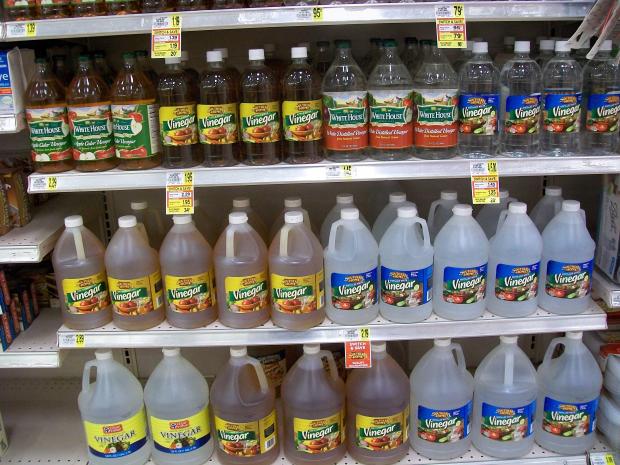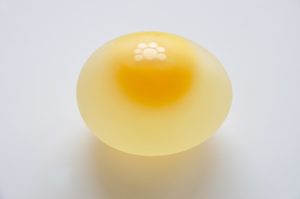
Vinegar for Peeling Eggs
Today’s “Merry Blogmas 2017” post is about the vinegar trick for peeling a hard-boiled or soft-boiled egg. This trick isn’t for everyone, but if you’ve tried the other “easy-peeling” measures that usually work, the vinegar trick may be for you.
PEELING EGGS BY UNDERSTANDING EGGS
Seriously, if you understand how an egg is built then peeling that egg is a lot easier. There’s a previous article on this blog that has discussed this topic in detail. It might help you to check it out.
We’re not going to cover peeling eggs in general. Today is just for the vinegar trick.
WHY ADDING VINEGAR HELPS IN PEELING EGGS
What’s in Vinegar
- Vinegar is dilute acetic acid in water.
- Some vinegars have other stuff in them. For example, apple cider vinegar has natural flavoring from the cider it was made from. It also has other apple cider ingredients like malic acid.
- Plain white vinegar is pretty pure in terms of water and acetic acid content.
You can use a different vinegar other than white vinegar but it won’t work as well because of dilution by the other ingredients. A different vinegar will also be more expensive because those other ingredients add value to it as a culinary tool.
White vinegar is just plain acetic acid plus water. It’s what you want to use on egg shells.
What’s in Egg Shells
Egg shells are mostly calcium carbonate with the chemical structure of the mineral aragonite. The bit about the aragonite structure doesn’t make anything easier or different for peeling eggs; but it is a cool fact that can entertain your friends and make your look smart and science-savvy.
It’s the chemical composition as calcium carbonate that matters. Why? Because most inorganic acids will dissolve calcium carbonate. This is so well known by geologists that the acid “fizz” test is the standard method of identifying limestone, which is mostly calcium carbonate.
Dilute acetic acid, better known as white vinegar, is one of those inorganic acids that dissolves calcium carbonate. What this means in terms in egg shells is this:
Putting white vinegar in your egg water will thin the egg shell.
This should be a no-brainer: thinner egg shells are easier to peel. A thick and hard shell is harder to crack without cracking the egg white underneath. Putting vinegar in your egg water will not help the separation of the membranes between the shell and the cooked egg white, which is the other obstacle in peeling eggs. Regardless, if you can’t crack an egg cooked in its shell without cracking the egg white at the same time before you start peeling, then try some vinegar in your egg water.
Here’s the Science
- The first thing that happens is the acetic acid breaks apart. Acetic acid is CH3COOH and it breaks into (C2H3O2)– and H+.
- The hydrogen ions reacts with the calcium carbonate egg shell to destroy the shell and produce water and carbon dioxide. The reaction is as follows:
- CaCO3+ 2H+ -> Ca+2 + H2O +CO2
- The calcium ions may bond with the acetate groups to form calcium acetate but that has no bearing on dissolving the egg shell.
INDECENT EGGS!
The vinegar trick really does work to thin an egg shell, You can run an experiment to demonstrate this. Here’s what to do:
- Put one or two eggs in a pot. Don’t let them touch each other.
- Cover the eggs with white vinegar. They will start to bubble immediately. The bubbles are some of the carbon dioxide that forms as the shells start to dissolve.
- Put a cover on the pot and put the post in the fridge. Let it sit for a day.
- After a day, remove the eggs CAREFULLY with a big spoon and put them in a bowl. The egg shell will now be very thin so less-than-gentle handling may break the membranes that separate the egg white from the shell.
- Dump the old vinegar, CAREFULLY put the eggs back in the pot and add fresh vinegar.
- Cover the pot and put it back in the fridge for another day.
- After the second day, you should now have shell-less eggs, held together by only the membranes. Remove them VERY CAREFULLY with a big spoon and put them in a bowl.
- If you actually want to use them in some scrambled eggs, rinse them off with water. Mix them 1:4 with other regular eggs or the scrambled eggs will be rubbery and taste a bit off. Discard and don’t use any that may have broken their encapsulating membranes. Don’t use a shell-less egg for baking: its pH will have shifted to less alkaline values and will foul up your recipes.
- Making naked eggs is a really fun thing to do if you have kids.

SOURCES
- https://www.exploratorium.edu/cooking/eggs/activity-naked.html
- https://www.education.com/science-fair/article/naked-egg/
- https://van.physics.illinois.edu/qa/listing.php?id=461
- https://sciencing.com/raw-egg-vinegar-experiments-8122302.html
Today’s banner image of vinegar in a story is by Ms. Angie Gray (2015), CC BY-SA 4.0 via Wikimedia Commons.

One thought on “Vinegar for Peeling Eggs”
Have done the “Naked Eggs” lab with 7th grade science but never thought about putting vinegar into my eggs when cooking. Thank you for this post and the information I can use to extend thinking with the lab as well. Would love to see more cooking and chemistry connections.